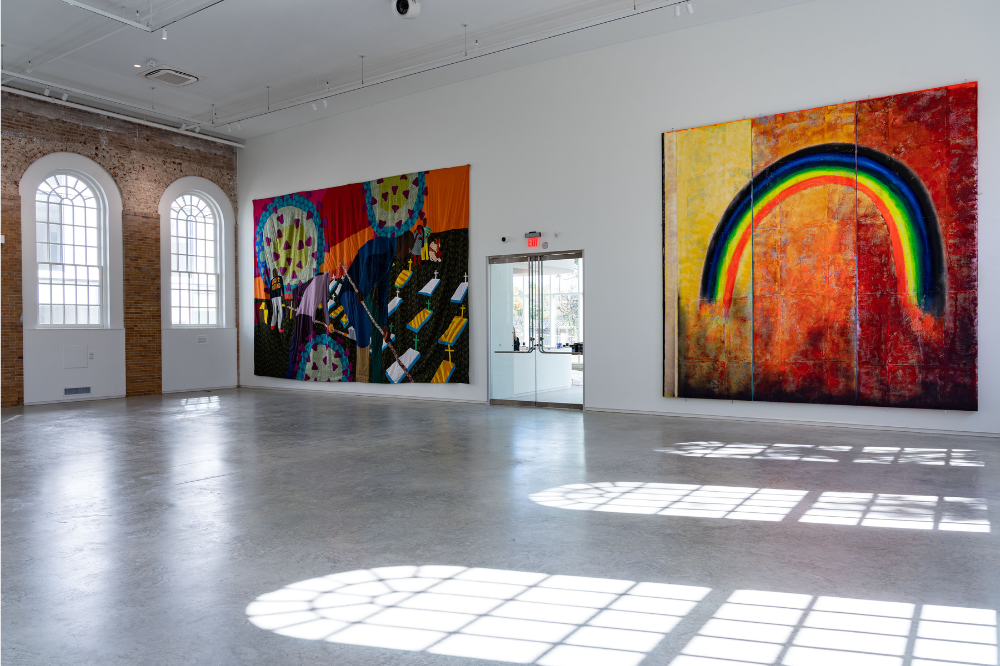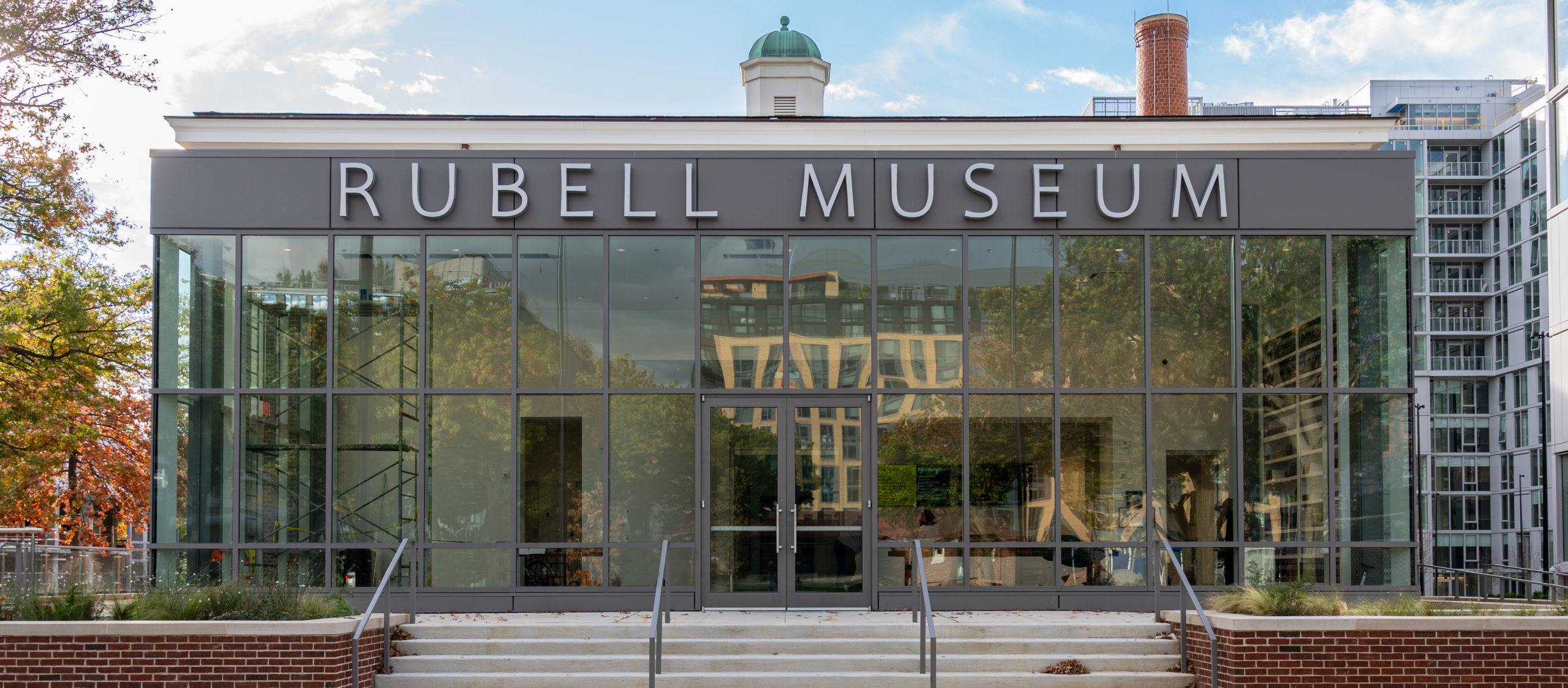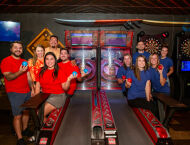Culture
 Installation view, left to right, Christopher Myers and Vaughn Spann, "Whats Going On." Photo by Chi Lam.
Installation view, left to right, Christopher Myers and Vaughn Spann, "Whats Going On." Photo by Chi Lam.
Rubell Museum DC, the City’s Newest World-Class Art Collection, Disrupts Local Scene
December 1, 2022 @ 12:00pm
If you’re an art lover in D.C., you already know we have enviable art collections of almost every period, region and movement in our many world-class cultural institutions. But you also know for all the perks (free admission and proximity to where we work, live and play), many of these museums were created for a national or international audience: the tourists who flock to the nation’s capital. D.C.’s own cultural heritage and contributions to the art world can seem a little lost in the shuffle.
Enter Rubell Museum DC, the District’s newest art museum that opened October 29. This Southwest D.C. museum is here to disrupt the scene.
This District-centric museum houses one of the most exciting contemporary art collections in the world.
“D.C. is so rich in arts and culture, so we’re just happy to add a different dimension and focus exclusively on contemporary art,” inaugural Director of Rubell Museum DC Caitlin Berry says.
Rubell Museum 1.0
The Rubell Museum — the first museum is located in Miami, where namesake owners Don and Mera live — boasts a formidable collection of contemporary works: bold, avant-garde, experimental and visionary.
“They are so unique and fearless in their vision and belief that art should be accessible to everyone,” Berry says. “[They believe] the participation supporting one’s art community through the purchase of artwork can start at any level.”
The Rubells’ story is one of foresight, luck and keeping it in the family. Shortly after marrying in 1964, the couple set aside a portion of Mera’s weekly paycheck ($25) and began purchasing art, visiting artists’ studios throughout New York City. Over the years, they amassed a major collection of more than 7,000 works and invested early in artists such as Jean-Michel Basquiat, Keith Haring, Jeff Koons, Cindy Sherman and Mickalene Thomas. Their son Jason, who studied art history, joined his parents in collecting the works and was instrumental in developing the two museums.
The Rubells have long been connected to D.C. through their real estate portfolio, which includes several area hotels. Their touring exhibitions and lent works have routinely landed at D.C. museums over the years.
From Randall to Rubell
The new site of Rubell Museum DC is in the location of the former Randall School, a segregated junior high school for Black students that closed in 1978. Redesigned by the architectural firm Beyer Blinder Belle, the 32,000 square-foot schoolhouse has exposed brick walls and large, arched windows that allow light to dapple through the galleries, exposed beams and ductwork overhead. There’s also polished white walls and gleaming wooden floors.
The space has been reimagined but retains its history and connections to the District in new ways. Possibly the most famous student to pass through the halls was singer-songwriter Marvin Gaye, who graduated in 1954.
“We discovered all these great images of Marvin: shots of him in the front row of his class picture outside the building, and of him singing in glee club in the former auditorium [now the main gallery],” Berry says. “What was happening in 1954? Brown v. the Board of Education was ruled and as schools desegregated, many families in this quadrant of D.C. were forced to move. Marvin then went on to join Motown [Records] and put together ‘What’s Going On’ in 1971, which was revolutionary at the time.”
Since opening the museum, Berry states one of the “unexpected, beautiful things” that’s happened is former Randall students visiting with their yearbooks and report cards, sharing personal memories with the staff.
“This is a multi-generational institution at this point, and we see their joy that this school has been brought back into use in this way. I hope we’re providing a place of respite and restoration for these folks in the community, to listen and talk to our community about their stories. To put this museum in an area of the city that’s not on the National Mall encourages members of the community to take ownership and experience the artwork that’s in their neighborhood museum.”

Rubell Museum. Photo by Chi Lam.
Welcome to D.C.
The grand opening of the museum was attended by Mayor Muriel Bowser, and a who’s who of artists and art world denizens, including Josh Baer, Jeffrey Deitch, Isabel Ernst, James Fuentes, Chase Hall, Reginald O’Neal, Anne Pasternak, Hank Willis Thomas, Genesis Tramaine, Kennedy Yanko
and Anita Zabludowicz. More than 5,000 patrons visited during opening weekend, which grants free admission to all D.C. residents.
“During the celebratory events leading up to our opening day, it was amazing to hold hands with Nekisha Durrett [a D.C.-based artist who suggested Berry for the position], Mera Rubell and Hank Willis Thomas,” Berry recalls. “Somehow, we’ve all made this work. The energy was so positive and I’m very thankful for our community.”
Two exhibitions are currently on view at Rubell Museum DC: a solo exhibition of Sylvia Snowden’s paintings and a group exhibition entitled “What’s Going On.” Snowden is a Howard University alumna and instructor, a lauded painter who has six decades of creating almost-sculptural abstract paintings — works deeply layered, both figuratively and literally. The current series on display, “Shell; Glimpses,” “is meant to honor her relationship with her daughter, manifested through layers of paint,” Berry says. “Sylvia even chose this particular gallery because of the light.”
“What’s Going On” brings together almost 200 works by 50 artists responding to sociopolitical problems of their times that still resonate today.
“I think one of the reasons [the Rubells] chose Washington as their second destination is because of the conversations that happen here at the intersection of culture and politics,” Berry says. “Social issues are uniquely amplified in Washington in a way they’re not anywhere else.”
The cornerstone of the exhibition is pop artist Keith Haring’s series “Untitled (Against All Odds)” (1989) dealing with environmental destruction, which was dedicated to Steve Rubell, Don’s brother and the owner of infamous disco nightclub Studio 54, who died of AIDS complications shortly beforehand. Haring listened to Gaye’s magnum opus, a work that also tackles thorny social issues, on repeat while working on the dystopic works.
“It’s just so beautiful to present these works in the school where Marvin Gaye walked the halls,” Berry elaborates. “There’s this sense of spirituality in a way and a metaphysical working of time and space. It feels like the right place at the right time to present and revisit these works because we continue to think about these issues.”
The exhibition also highlights many D.C. contemporary artists within the Rubells’ personal collection, from muralist Jamea Richmond-Edwards who lives in Silver Spring; Hank Willis Thomas, who attended Duke Ellington High School; painter February James and postmodern sculptor Cady Noland.
Berry, who was previously director of the Cody Gallery at Marymount University, knows the importance of thinking and working locally, even when presenting exhibitions and a collection with international acclaim.
“I feel it’s an enormous responsibility because this community is my home. I’ve spent about a decade in the city and the artists here have really trusted me to present their work in various capacities. Being entrusted with this position is a big job.”
Both exhibitions are on display for an indeterminate time, Berry explains, so locals have time to see the works and get to know their new neighborhood world-class museum of contemporary art. Soon, the museum will announce its public programming and find new avenues of engagement with Washingtonians.
“Our programming will resonate on a local and national level using works in the collection that are on view. First and foremost, we value the artist, their voice and their perspective. You can anticipate ample artists’ talks, bringing in different perspectives from the community, D.C. history and maybe some collaborations with other institutions.”
Closing dates for “What’s Going On” and “Shell; Glimpses” have not yet been announced. Free admission to D.C. residents.
Rubell Museum DC: 65 I (Eye) St. SW, DC; rubellmuseum.org // @rubellmuseumdc







